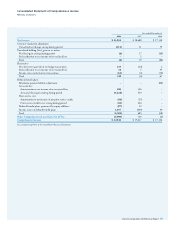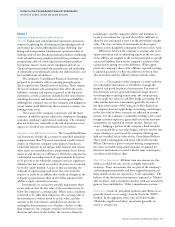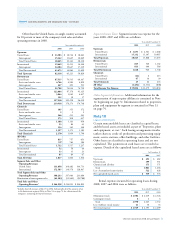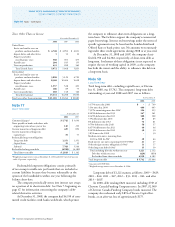Chevron 2008 Annual Report Download - page 71
Download and view the complete annual report
Please find page 71 of the 2008 Chevron annual report below. You can navigate through the pages in the report by either clicking on the pages listed below, or by using the keyword search tool below to find specific information within the annual report.
Chevron Corporation 2008 Annual Report 69
company uses to value an asset or a liability. The three levels
of the fair-value hierarchy are described as follows:
Level 1: Quoted prices (unadjusted) in active markets
for identical assets and liabilities. For the company,
Level 1 inputs include exchange-traded futures con-
tracts for which the parties are willing to transact at
the exchange-quoted price and marketable securities
that are actively traded.
Level 2: Inputs other than Level 1 that are observable,
either directly or indirectly. For the company, Level 2
inputs include quoted prices for similar assets or liabili-
ties, prices obtained through third-party broker quotes,
and prices that can be corroborated with other observ-
able inputs for substantially the complete term of
a contract.
Level 3: Unobservable inputs. The company does not
use Level 3 inputs for any of its recurring fair-value
measurements. Beginning January 1, 2009, Level 3
inputs may be required for the determination of fair
value associated with certain nonrecurring measure-
ments of nonfinancial assets and liabilities.
The fair-value hierarchy for assets and liabilities mea-
sured at fair value at December 31, 2008, is as follows:
Assets and Liabilities Measured at Fair Value on a Recurring Basis
Prices in Active
Markets for Other
Identical Observable Unobservable
At December 31 Assets/Liabilities Inputs Inputs
2008 (Level 1) (Level 2) (Level 3)
Marketable Securities $ 213 $ 213 $ – $ –
Derivatives 805 529 276 –
Total Assets at Fair Value $1,018 $ 742 $ 276 $ –
Derivatives $ 516 $ 98 $ 418 $ –
Total Liabilities at Fair Value $ 516 $ 98 $ 418 $ –
Marketable securities The company calculates fair value for
its marketable securities based on quoted market prices for
identical assets and liabilities.
Derivatives The company records its derivative instru-
ments – other than any commodity derivative contracts that
are designated as normal purchase and normal sale – on the
Consolidated Balance Sheet at fair value, with virtually all the
offsetting amount to income. For derivatives with identical
or similar provisions as contracts that are publicly traded on a
regular basis, the company uses the market values of the pub-
licly traded instruments as an input for fair-value calculations.
The company’s derivative instruments principally
include crude oil, natural gas and refined-product futures,
swaps, options and forward contracts, as well as interest-rate
swaps and foreign currency forward contracts. Derivatives
classified as Level 1 include futures, swaps and options con-
tracts traded in active markets such as the NYMEX (New
York Mercantile Exchange).
Derivatives classified as Level 2 include swaps (includ-
ing interest rate), options, and forward (including foreign
currency) contracts principally with financial institutions
and other oil and gas companies, the fair values for which
are obtained from third-party broker quotes, industry pric-
ing services and exchanges. The company obtains multiple
sources of pricing information for the Level 2 instruments.
Since this pricing information is generated from observable
market data, it has historically been very consistent. The
company does not materially adjust this information. The
company incorporates internal review, evaluation and assess-
ment procedures, including a comparison of Level 2 fair
values derived from the company’s internally developed for-
ward curves (on a sample basis) with the pricing information
to document reasonable, logical and supportable fair-value
determinations and proper level of classification.
Note 9
Operating Segments and Geographic Data
Although each subsidiary of Chevron is responsible for its
own affairs, Chevron Corporation manages its investments
in these subsidiaries and their affiliates. For this purpose,
the investments are grouped as follows: upstream – explora-
tion and production; downstream – refining, marketing and
transportation; chemicals; and all other. The first three of
these groupings represent the company’s “reportable segments”
and “operating segments” as defined in Financial Accounting
Standards Board (FASB) Statement No. 131, Disclosures About
Segments of an Enterprise and Related Information (FAS 131).
The segments are separately managed for investment
purposes under a structure that includes “segment managers”
who report to the company’s “chief operating decision maker”
(CODM) (terms as defined in FAS 131). The CODM is
the company’s Executive Committee, a committee of senior
officers that includes the Chief Executive Officer and that, in
turn, reports to the Board of Directors of Chevron Corporation.
The operating segments represent components of the
company as described in FAS 131 terms that engage in activi-
ties (a) from which revenues are earned and expenses are
incurred; (b) whose operating results are regularly reviewed
by the CODM, which makes decisions about resources to be
allocated to the segments and to assess their performance;
and (c) for which discrete financial information is available.
Segment managers for the reportable segments are
accountable directly to and maintain regular contact with the
company’s CODM to discuss the segment’s operating activities
and financial performance. The CODM approves annual
capital and exploratory budgets at the reportable segment level,
as well as reviews capital and exploratory funding for major
Note 8 Fair Value Measurements – Continued
























